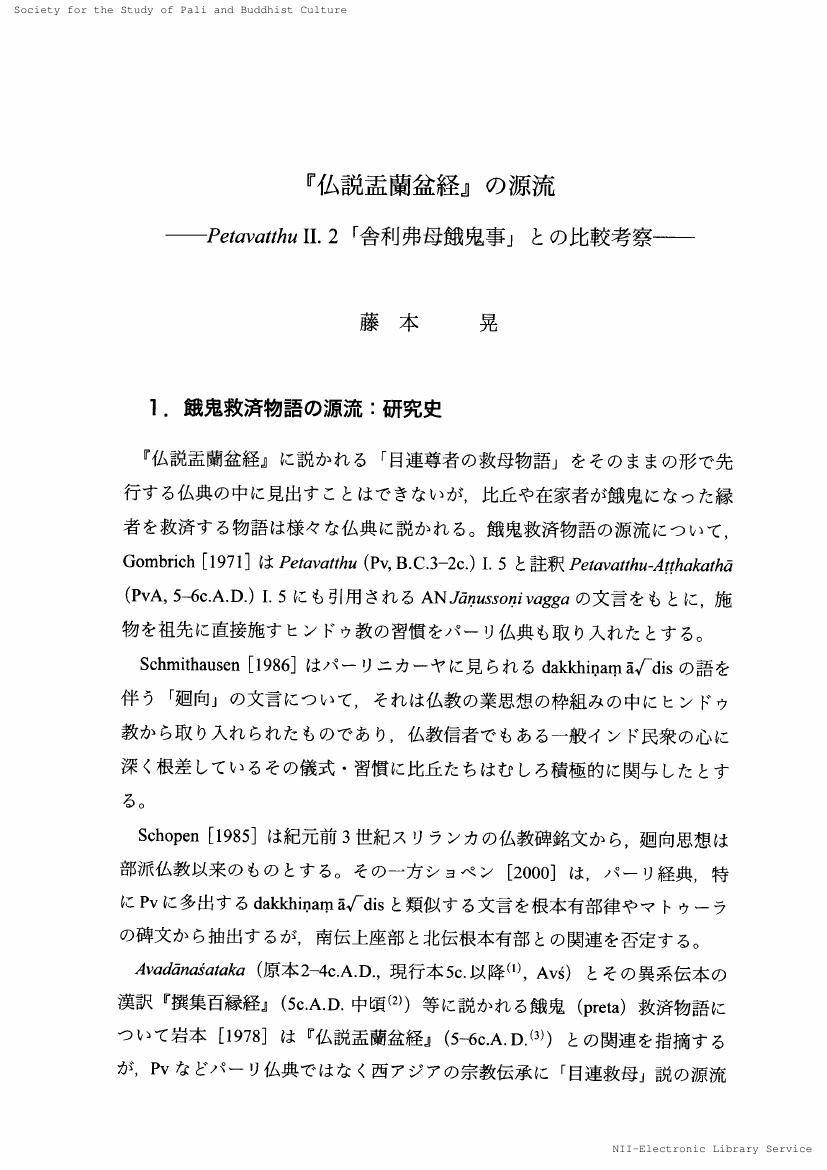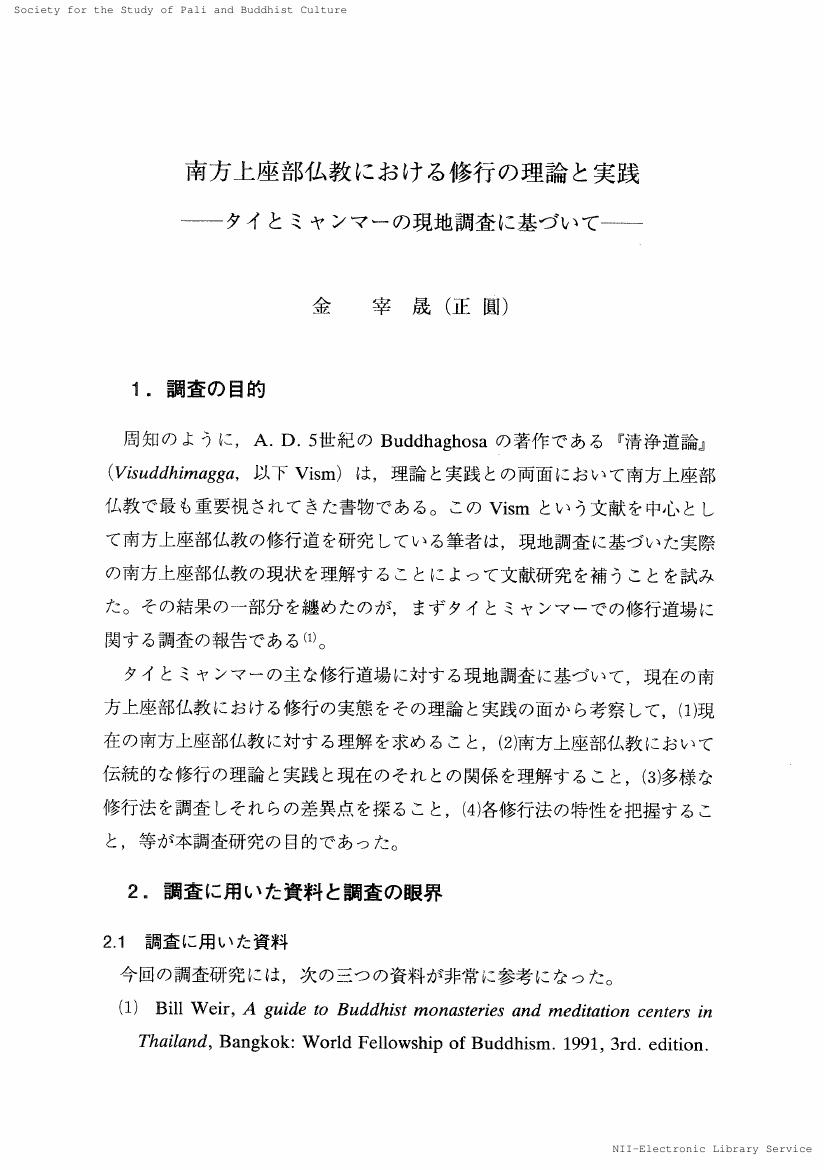38 0 0 0 OA 『仏説孟蘭盆経』の源流 : Petavatthu II.2「舎利弗母餓鬼事」との比較考察
- 著者
- 藤本 晃
- 出版者
- パーリ学仏教文化学会
- 雑誌
- パーリ学仏教文化学 (ISSN:09148604)
- 巻号頁・発行日
- vol.17, pp.47-54, 2003-12-20 (Released:2018-09-01)
8 0 0 0 スリランカの大谷探検隊
- 著者
- 入澤 崇
- 出版者
- パーリ学仏教文化学会
- 雑誌
- パーリ学仏教文化学 (ISSN:09148604)
- 巻号頁・発行日
- vol.17, pp.11-20, 2003
7 0 0 0 具足戒を授くべからざる二十人
- 著者
- 入澤 崇
- 出版者
- パーリ学仏教文化学会
- 雑誌
- パーリ学仏教文化学 (ISSN:09148604)
- 巻号頁・発行日
- no.2, pp.105-117, 1989-03-05
4 0 0 0 預流果への道 : 随法行と随信行
- 著者
- 藤本 晃
- 出版者
- パーリ学仏教文化学会
- 雑誌
- パーリ学仏教文化学 (ISSN:09148604)
- 巻号頁・発行日
- no.19, pp.53-63, 2005-12-20
3 0 0 0 OA Satipatthana Suttaにおける「内・外」について
- 著者
- 井上 ウィマラ
- 出版者
- パーリ学仏教文化学会
- 雑誌
- パーリ学仏教文化学 (ISSN:09148604)
- 巻号頁・発行日
- vol.27, pp.1-19, 2013-12-22 (Released:2018-09-01)
Mindfulness meditation is expounded most comprehensively and systematically in the Satipatthana sutta in the Majjhima Nikaya. After explaning how to establish mindfulness with 13 concrete objects (categorized into 4 areas of body, feelings, mind and dhammas), the sutta repeatedly mentions the formula regarding the insight that is to be attained by the practitioner. In this refrain, it introduces the triad of ajjhatta (internally), bahiddha (externally) and ajjhatta-bahiddha (internally and externally) necessary for the purpose of carrying out continuous observation. It is this triad that constitutes the main theme of this paper. Analayo's Satipatthana: The Direct Path to Realization (2003) is a thorough research work on this sutta, which includes traditional interpretation, works of modern scholarship, and teachings of present-day meditation teachers. I will, in this paper, summarize his treatment of this theme, "internal and external contemplation." It is Analayo's conclusion that the commentarial and Abhidhammic position to identify the "internal and external" with the "self and others" is the most appropriate and practical interpretation. Building on his philological work, I wish to introduce some information from the Mahavagga in the Vinaya about the reciprocal practice of taking care of each other: the duties of teachers and disciples, the five conditions of a patient who is difficult to take care of and the five conditions of the practitioner who is able to take care of a patient. These situations inevitably lead the practitioner to observe not only others but also oneself. In the Ambalatthikarahulovada sutta from the Majjhima Nikaya, Buddha admonishes Rahula to reflect on his actions as to whether they give pain to oneself, to others or to both. This perspective of "self, others and both" constitutes a counterpart to the triad of "internally, externally, and both internally and externally." The Buddha, further, taught Rahula to confess and reveal unwholesome bodily and oral actions that produce painful results for one's teachers and fellow practitioners of the holy path, while repelling and feeling ashamed of one's unwholesome mental actions. This suggests that bodily and oral actions are shared within interpersonal relationships while mental actions stay confined to oneself. Abhidhamma explains hiri to be the feeling of being ashamed of oneself, while otappa is the feeling of being ashamed toward someone on the outside. This suggests that there exists someone internalized deep in our psyche. In this regard, the Khandha Samyutta discusses the existence of various layers of consciousness, with or without the concept of "I," "me" and "mine." Taking all these into account, the framework of ajjhatta, bahiddha and ajjhattabahiddha functions as the observational perspective, in which a practitioner witnesses the process by which the concepts of "self' and "others" are formed.
- 著者
- 逢坂 雄美 山崎 守一
- 出版者
- パーリ学仏教文化学会
- 雑誌
- パーリ学仏教文化学 (ISSN:09148604)
- 巻号頁・発行日
- vol.15, pp.167-176, 2001-12-20 (Released:2018-09-01)
- 著者
- 平木 光二
- 出版者
- パーリ学仏教文化学会
- 雑誌
- パーリ学仏教文化学 (ISSN:09148604)
- 巻号頁・発行日
- vol.30, pp.65-86, 2016 (Released:2018-09-01)
The general impression of Myanmar monks is that they do not participate in politics. However, even under the military regime which has suppressed political activities by force, Buddhist monk activists have existed. Wirathu, a Buddhist monk activist, launched an anti-Islam campaign called 969 through anti-Islam hate speech and the distribution of propaganda leaflets to citizens by establishing a hard-line group for Protection of Race and Religion (MaBaTha). The author sets up a hypothesis that the islamophobia held by successive presidents and racist monks has been a primary factor of ethno-religious conflict between Myanmar-muslims including the Rohingyas and ethnic Rakhine (Arakanese), Mon and Myanmar Buddhists. For a better understanding of the features of MaBaTha that have been rumored to incite racially and religiously triggered violence, the author questioned the legitimacy of the emblem of the 969 campaign and that of establishment of a religious group. The results show that the emblem of the 969 campaign is not officially approved by the Ministry of Religious Affairs and that Wirathu was ordered not to establish a religious association by the State Sangha Maha Nayaka Committee which is a government-appointed body that oversees Buddhist monkhood. Despite that, why could Wirathu continue the 969 campaign? The author suggests the reason is that islamophobic President Thein Sein afforded Wirathu and MaBaTha special benefit in every way, which enabled him to openly participate in politics. The study concludes Myanmar people’s innermost fear of Islam has been the primary factor of conflicts between Myanmar-muslims and ethnic Rakhine (Arakanese), Mon and Myanmar Buddhists.
3 0 0 0 OA ピプラフワの遺跡発掘の成果 : スリブァスタヴァ報告の紹介
- 著者
- 武田 龍
- 出版者
- パーリ学仏教文化学会
- 雑誌
- パーリ学仏教文化学 (ISSN:09148604)
- 巻号頁・発行日
- vol.11, pp.71-81, 1998-05-20 (Released:2018-09-01)
3 0 0 0 OA 南方上座部仏教における修行の理論と実践 : タイとミャンマーの現地調査に基づいて
- 著者
- 金 宰晟
- 出版者
- パーリ学仏教文化学会
- 雑誌
- パーリ学仏教文化学 (ISSN:09148604)
- 巻号頁・発行日
- vol.10, pp.37-63, 1997-05-20 (Released:2018-09-01)
3 0 0 0 仏陀と形而上学 : 無記説に対する諸解釈を中心に
- 著者
- 金 龍煥
- 出版者
- パーリ学仏教文化学会
- 雑誌
- パーリ学仏教文化学 (ISSN:09148604)
- 巻号頁・発行日
- no.9, pp.71-90, 1996-05-20
- 著者
- 藤本 晃
- 出版者
- パーリ学仏教文化学会
- 雑誌
- パーリ学仏教文化学 (ISSN:09148604)
- 巻号頁・発行日
- no.17, pp.47-54, 2003-12-20
3 0 0 0 仏教の伝承
- 著者
- 水野 弘元
- 出版者
- パーリ学仏教文化学会
- 雑誌
- パーリ学仏教文化学 (ISSN:09148604)
- 巻号頁・発行日
- no.4, pp.1-16, 1991-05-30
- 著者
- 岡本 健資
- 出版者
- パーリ学仏教文化学会
- 雑誌
- パーリ学仏教文化学 (ISSN:09148604)
- 巻号頁・発行日
- vol.31, pp.51-72, 2017 (Released:2019-02-01)
- 被引用文献数
- 1
The story of Śākyamuni’s descent to earth after preaching for his mother Māyā in Tāvatiṃsa heaven is found in many Buddhist texts and artworks, and thus seems to have been regarded as one of the important events in Śākyamuni’s biography. However, there are some differences between its various versions. In this paper, I will first focus on its version in the Dhammapada-Aṭṭhakathā. Then, I will compare this version with others (found in Za ahan jing, Zengyi ahan jing, Yizu jing, Genben shuo yiqie youbu pinaiye zashi [= Chinese version of the Mūlasarvāstivādavinaya-kṣudrakavastu], Jātaka-Aṭṭhakathā, Paramattha-jotikā, etc.), examining differences between them. In doing so, I will make clear the tradition to which the version in the Dhammapada-Aṭṭhakathā belongs.
2 0 0 0 OA 原始仏教聖典におけるattanとbrahman
- 著者
- 西 昭嘉
- 出版者
- パーリ学仏教文化学会
- 雑誌
- パーリ学仏教文化学 (ISSN:09148604)
- 巻号頁・発行日
- vol.17, pp.29-36, 2003-12-20 (Released:2018-09-01)
2 0 0 0 OA The Gospel of Buddha 受容の諸相 福音か疑経か
- 著者
- 長尾 佳代子
- 出版者
- パーリ学仏教文化学会
- 雑誌
- パーリ学仏教文化学 (ISSN:09148604)
- 巻号頁・発行日
- vol.34, pp.61-83, 2021 (Released:2022-08-27)
The Gospel of Buddha, written and published in English by Paul Carus in 1894, was translated into Japanese by Daisetsu Suzuki the following year and was subsequently translated into various languages and read by many people. Despite this widespread interest, its content was severely criticized by Western philologists. This is because the book, which is a combination of both the Pali Canon and Mahāyāna writings, was considered inappropriate as a representation of Buddhist philosophy. Carus argued that his writings reflected the original ideas of Śākyamuni. This paper establishes that Carus was trying to show “the Religion of Science” he advocated by arbitrarily selecting Buddhist books, including translations of the Pali Canon. Next, using materials such as related works and letters, this paper shows that Carus had experience interacting with Japanese monks and preferred them to Christian clergymen because they were “not hampered by any creed.” This attitude of Carus’, who regarded Japanese Buddhism as a kind of philosophy rather than as a religion and expected it to develop into a scientific religion, was well received not only by Japanese Buddhists who were trying to establish modern Buddhism, but also by other Japanese intellectuals.
2 0 0 0 ピプラフワの遺跡発掘の成果 : スリブァスタヴァ報告の紹介
- 著者
- 武田 龍
- 出版者
- パーリ学仏教文化学会
- 雑誌
- パーリ学仏教文化学 (ISSN:09148604)
- 巻号頁・発行日
- vol.11, pp.71-81, 1998
2 0 0 0 OA 慧解脱者は四禅を必要としないのか
- 著者
- コンカーラッタナラック プラポンサック
- 出版者
- パーリ学仏教文化学会
- 雑誌
- パーリ学仏教文化学 (ISSN:09148604)
- 巻号頁・発行日
- vol.26, pp.1-13, 2012-12-22 (Released:2018-09-01)
It is the highest purpose in Buddhism to detach all pains (dukkha), attain the nirvana (nibbana), and become an arhat (arahant). However, among the arhats who have achieved spiritual enlightenment, various kinds of arthats exist. In SN.8.7 Pavarana (SN.I.191), the Buddha explained four kinds of arhats that tevijja, chalabhinna, ubhatobhagavimutta, pannnavimutta. In this text, tevijja and chalabhinna are explained as an arhat who is "a possessor of the threefold clear vision" and "a possessor of the six branches of higher knowledge," respectively. However, the explanation about ubhatobhagavimutta and pannavimutta is not clear in this text. On the other hand, both kinds of arhat are variously explained in other places. How then should we understand these two terms? At first glance, ubhatobhagavimutta is those who have attained cetovimutti and pannavimutti, and pannavimutta is those who have attained only pannavimutti. In addition, according to AN.2.3 Bala-vagga 10 (AN.I.61) in connection with cetovimutti and pannavimutti, one would leave raga and attain cetovimutti by practicing samatha. On the other hand, one would leave avijja and attain pannavimutti by practicing vipassana. According to the above viewpoint, ubhatobhagavimutta will mean those who practice samatha and vipassana for the attainment of cetovimutti and pannavimutti. And pannavimutta is those who practice only vipassana just for the attainment of pannavimutti. In other word, it could be understood here that ubhatobhagavimutta requires jhana or aruppa, whereas pannavimutta requires neither jhana nor aruppa. However, is that right? If it was right, why has the example of pannavimutti mentioned independently not yet found in the early Pali Canon (Nikaya) despite of a plenty of examples that cetovimutti and pannavimutti are mentioned together? In order to understand this problem, especially the relation between pannavimutta and jhana from the early Pali Canon's point of view, I have studied the previous works focused on the early Pali Canon and have reached to the following conclusions. 1. At first glance, ubhatobhagavimutta is those who have attained cetovimutti and pannavimutti, and pannavimutta is those who have attained only pannavimutti. The former is so, but the latter is not. Unlike its term, pannavimutta has attained not only pannavimutti but cetovimutti as well. This is why, in early Pali Canon, we have not found the example of pannavimutti mentioned independently despite of a plenty of examples that cetovimutti and pannavimutti are mentioned together. 2. Ubhatobhagavimutta is explained that they experience santa vimokha and attha vimokha. Santa vimokha and attha vimokha are the spiritual stage of aruppa which is beyond jhana. On the other hand, although pannavimutta has no experience of either santa vimokha or attha vimokha, they also attain cetovimutti, not only pannavimutti. This clarifies that samatha was needed by pannavimutta. However, samatha mentioned here is only a stage of jhana for the attainment of cetovimutti, not yet attaining the stage of aruppa. In short, pannavimutta needs jhana.
- 著者
- 青野 道彦
- 出版者
- パーリ学仏教文化学会
- 雑誌
- パーリ学仏教文化学 (ISSN:09148604)
- 巻号頁・発行日
- no.25, 2011-12-22
2 0 0 0 モンゴルにおける浄土思想
- 著者
- 嘉木場 凱朝
- 出版者
- パーリ学仏教文化学会
- 雑誌
- パーリ学仏教文化学 (ISSN:09148604)
- 巻号頁・発行日
- vol.17, pp.21-28, 2003
2 0 0 0 四大教法(Cattaro Mahapadesa)について
- 著者
- 片山 一良
- 出版者
- パーリ学仏教文化学会
- 雑誌
- パーリ学仏教文化学 (ISSN:09148604)
- 巻号頁・発行日
- no.2, pp.55-68, 1989-03-05




